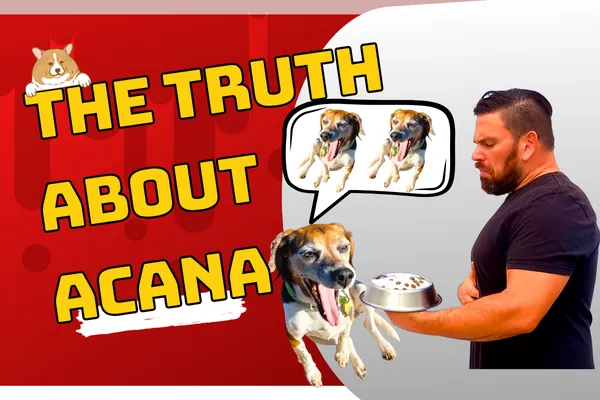
Acana Dog Food Review 2025
Is Acana Dog Food Good for Dogs?
Premium Price, Problematic Ingredients
For years, Acana built a reputation as a “premium” dog food brand. Loyal fans swore by it, defended it online, and happily paid top prices for what was marketed as a high-quality, grain-free food.
But times have changed.
Today, Acana dog food faces serious quality concerns—especially for senior dogs—that every pet parent needs to know before buying.
In this review, we’ll look at:
🥤 How Acana changed after corporate buyouts
🍟 The hidden risks in its formulas
⚠️ Ingredient tricks that deceive consumers
🍩 Why high carbs and poor omega ratios make it dangerous for older dogs
🍗 What to feed instead
Acana Dog Food Review 2025 (Table of Contents)
Is Acana Dog Food Good for Dogs?
Premium Price, Problematic Ingredients
Acana’s History and the Mars Takeover
Formula Changes and Declining Quality
The DCM Risk: Too Many Peas and Lentils
High Carbohydrate Load = Hidden Sugars
The Omega 3 Fatty Acid Debacle
Final Verdict: Should You Buy Acana?
Acana’s History and the Mars Takeover
🐾 Once respected: Years ago, Acana had a decent reputation. It was pricey, but quality wasn’t terrible.
🏢 Corporate buyouts: First, an investment firm stepped in. Later, in 2023, Acana and its sister brand Orijen were sold to Mars, Inc. — the same company behind Snickers and M&Ms, as well as dozens of pet food brands.
⚠️ Immediate decline: Once these takeovers happen, ingredient quality almost always drops. Retailers even began pulling Acana from shelves due to customer complaints.
Formula Changes and Declining Quality
🔄 By law, pet food companies have six months to update their websites after changing formulas. That means you could be buying a bag that’s very different from what’s advertised online.
❗ Customers have reported dogs developing:
Hotspots
Fur loss
Digestive issues
General illness
For a brand that sells itself as “premium,” this is unacceptable.
The DCM Risk: Too Many Peas and Lentils
🥬 Acana’s formulas are now packed with peas, lentils, and pea proteins.
❤️ This raises concerns about DCM (Dilated Cardiomyopathy) — a potentially fatal heart condition linked to legumes in dog food.
The science isn’t 100% settled on DCM and it's link to peas, but ask yourself: do you want to gamble with your dog’s heart? Especially with a senior dog, the risk is too high. For peas? So that dog food companies can put billions in their pockets selling us PEAS?
Nah, thanks, but nah. I'll stick to feeding my dog people foods (ya know, REAL foods)
👉 And remember: these peas and lentils aren’t whole-food quality. They’re cooked down into starchy, sugary fillers—essentially empty carbs.

Ingredient Splitting Tricks
🕵️ Ingredient splitting is a label trick used to disguise just how much of a formula is made up of cheap fillers.
Example: Instead of listing “peas – 30%,” Acana can break it up into:
Green peas
Yellow peas
Pea protein
Pea starch
Each appears as a different ingredient on the label, but together they dominate the formula. The same trick happens with lentils: red, yellow, orange.
It gets around them needing to say, hey, pet parent... this 90€ bag of food is 40% peas and lentils
👉 This is a marketing illusion—designed to make you believe the food is more meat-based than it really is.
High Carbohydrate Load = Hidden Sugars
🍬 Many Acana recipes test at 26–35% carbohydrates.
⚠️ Dog food companies don’t have to list carbs on the label, so you never see “30% sugar” written out—but that’s the reality.
Why it matters for senior dogs:
🦴 Joint inflammation
🧠 Cognitive decline
⚠️ Organ stress
🎗️ Cancer risk (sugar can fuel tumor growth)
For a brand marketed as “low carb” and “grain-free”, this is a major red flag.
The Problem with “Meals”
Acana uses multiple “meals” in their formulas (chicken meal, salmon meal, duck meal).
Sounds good, right? Duck and chicken and salmon, those are REAL FOODS!
Wrong.
What “meal” really means:
🪶 Beaks and blood and hooves and hydes
🐔 Feathers
🦴 Tendons
🐄 Scraps not fit for human consumption
These are cooked down into powders and pressed into kibble. By the time they reach your dog’s bowl, they’re devoid of real nutrition.
Even in the salmon recipe, after whole salmon, the next ingredients include two fish meals plus lentils and peas. That’s not premium—it’s filler.
The Omega 3 Fatty Acid Debacle
🐟 You’d think a salmon-based food would be rich in omega-3s, right? Wrong again.
Lab analyses show:
Less than 0.2% EPA/DHA (the most important omega-3s).
Double the omega-6s compared to omega-3s.
This imbalance promotes inflammation—exactly what senior dogs don’t need.
👉 A food sold as “salmon premium” should be omega-rich. Instead, Acana fails one of the most basic nutritional tests. By the way, it's not just Acana, many vet approved dog foods, special formulas for dogs with Cancer, CKD, Liver problems, and even senior dog foods are loaded with omega 6's and are woefully lacking in Omega 3.
Final Verdict: Should You Buy Acana?
🚫 No.
Acana may have once been decent, but today it’s:
Overpriced
Loaded with fillers, legumes, and carbs
Deceptively labeled
Nutritionally unbalanced
For senior dogs especially, these problems are unacceptable.
✅ Better Options
Homemade dog food → cheaper, healthier, and transparent.
If you must buy commercial: look for independent brands with transparent sourcing and formulas low in carbs and legumes. Click Here for our playlist of the Best and Worst Commercial Dog Foods
Best option? Click the image below and get your beginners guide (FREE) to making healthy homemade dog food for your adult or senior dog. Want your dog to live longer? Download this guide...
